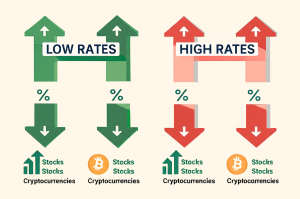
The Qubic-Monero Saga: A Deep Dive into the 51% Hashrate Controversy
Introduction: A Clash of Ideologies in the Cryptocurrency Arena
The cryptocurrency world is no stranger to controversy, but few incidents have sparked as much debate as the recent clash between Qubic and Monero. This confrontation, which pitted an ambitious blockchain project against a privacy-focused cryptocurrency, has raised critical questions about network security, decentralization, and the ethical boundaries of leveraging one blockchain’s resources to influence another. The saga began when Qubic, a digital asset project, released a report outlining its strategy to amass up to 51% of Monero’s network hashrate. This bold move has ignited a firestorm of discussion within the crypto community, with some viewing it as a legitimate business strategy and others as a hostile takeover attempt. To fully understand the implications of this event, it is essential to examine the details, the motivations, and the broader implications for the cryptocurrency ecosystem.
Qubic’s Strategic Ambitions: “Warming Up the Engines”
Qubic’s strategy, as detailed in their report titled “Warming Up the Engines,” was anything but subtle. The project openly declared its intentions to gain control over a significant portion of Monero’s hashrate, with a specific focus on a “dominance window” projected from August 2 to August 31, 2025. The report provided a transparent breakdown of Qubic’s financial performance in Monero mining operations, revealing earnings of $180,250 from the sale of 459 units. This level of transparency, while unusual, underscored Qubic’s confidence in its approach.
The core of Qubic’s strategy revolved around a concept they termed “useful proof of work” (uPoW). By offering miners richer payouts than ordinary pools, Qubic aimed to attract enough hashing power to surpass the 51% threshold. This approach was essentially a pay-to-switch mining campaign, enticing miners with the promise of greater profitability. Initially, Qubic planned to fund this campaign by mining Monero, buying and burning Qubic tokens to drive up their price. However, they later adjusted their strategy so that Monero mining profits would go directly to Qubic validators. This shift in approach demonstrated Qubic’s adaptability and willingness to modify its tactics to achieve its goals.
The 51% Attack: A Threat to the Foundations of Decentralization
The significance of controlling 51% of a network’s hashrate cannot be overstated. In a proof-of-work blockchain like Monero, miners compete to solve complex cryptographic puzzles to add new blocks to the chain. The miner with the most computational power, or hashrate, has the highest probability of solving these puzzles and adding blocks. When a single entity controls more than half of the hashrate, it gains the ability to manipulate the blockchain in several ways:
– Orphaning Rival Blocks: The entity can reject and replace valid blocks mined by other participants, effectively censoring their transactions.
– Delaying Confirmations: The entity can prevent specific transactions from being included in the blockchain, causing significant delays.
– Double-Spending: The entity can reverse transactions they initiated, allowing them to spend the same coins twice.
These capabilities directly undermine the core principles of decentralization and trust that underpin cryptocurrencies. A successful 51% attack could severely damage Monero’s reputation and erode confidence in its security. The potential consequences of such an attack extend beyond the immediate financial losses. They could also undermine the broader cryptocurrency ecosystem by demonstrating the vulnerability of proof-of-work networks to centralized control.
Monero’s Resilient Defense: Community and Technology
The Monero community did not remain passive in the face of Qubic’s ambitions. A vocal opposition emerged across various platforms, including X (formerly Twitter) and Reddit, raising awareness about the potential threat and urging miners to remain loyal to the network’s decentralization. This grassroots movement played a crucial role in thwarting Qubic’s plans.
Miners themselves demonstrated a strong commitment to the long-term health and integrity of the Monero network. Many refused to switch to the Qubic pool, even with the promise of higher payouts. This widespread boycott significantly hampered Qubic’s ability to reach the 51% threshold. The miners’ actions highlighted the power of community resistance in maintaining the security and decentralization of a blockchain network.
In addition to community efforts, Monero’s developers have consistently worked to enhance the network’s resilience against attacks. Monero uses the RandomX proof-of-work algorithm, which is designed to be ASIC-resistant. This means it favors CPUs and GPUs over specialized mining hardware, making it more difficult for a single entity to accumulate a massive amount of hashing power. The RandomX algorithm’s resistance to ASICs has been a key factor in maintaining Monero’s decentralization and security.
Cross-Chain Mining: A Double-Edged Sword
The Qubic-Monero saga raises important questions about the future of cross-chain mining and the security of smaller proof-of-work networks. Qubic’s strategy hinged on the concept of leveraging resources from one blockchain (Qubic) to influence another (Monero). This approach, if successful, could set a precedent for future attacks and raise concerns about the interconnectedness of the crypto ecosystem.
The incident highlights the risks of hashpower centralization in small blockchains using shared consensus mechanisms like uPoW. If a larger chain can effectively “borrow” hashing power from a smaller chain, it could potentially destabilize the smaller network. This is a particularly relevant concern for emerging cryptocurrencies with relatively low hashrates, making them vulnerable to attacks from more established projects.
The broader implications of cross-chain mining extend beyond the immediate threat of a 51% attack. They also raise questions about the ethical boundaries of leveraging one blockchain’s resources to influence another. As the cryptocurrency ecosystem continues to evolve, it will be crucial to establish clear guidelines and best practices for cross-chain interactions to ensure the security and stability of all networks.
Publicity Stunt or Genuine Ambition?
Following the thwarted 51% attack, some within the Monero community dismissed Qubic’s efforts as a mere publicity stunt. From this perspective, Qubic intentionally courted controversy to gain attention and boost its own project’s visibility. While it is undeniable that the saga generated significant buzz around Qubic, attributing their actions solely to a publicity stunt may be an oversimplification.
Qubic did invest resources in mining Monero and attempting to attract miners to their pool. It is possible that they genuinely believed they could achieve their goals and influence the Monero network. Alternatively, they may have believed that a failed attempt, even if it did not achieve full control, would be beneficial to them through the increased exposure. The motivations behind Qubic’s actions remain a subject of debate, but the incident has undoubtedly raised important questions about the ethics of leveraging controversy to gain attention in the cryptocurrency world.
Conclusion: Lessons Learned and the Path Forward
The Qubic-Monero saga serves as a valuable case study in the ongoing evolution of cryptocurrency security and governance. It highlights the importance of community vigilance, the resilience of well-designed protocols, and the potential risks associated with cross-chain mining strategies. While Qubic’s attempt to control Monero’s hashrate ultimately failed, the incident has prompted important conversations about decentralization, network security, and the ethics of leveraging one blockchain’s resources to influence another.
As the cryptocurrency landscape continues to evolve, these lessons will be crucial in safeguarding the integrity and security of decentralized networks. The failed attempt might have revealed the need for new approaches to ensure decentralization is maintained as these cross-chain techniques evolve. The engines may have been warming up, but the community kept them from taking off. The saga underscores the importance of remaining vigilant and proactive in the face of potential threats to the cryptocurrency ecosystem. By learning from this incident, the community can better prepare for future challenges and ensure the continued growth and stability of decentralized networks.





